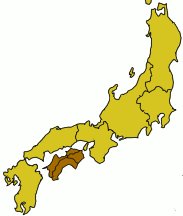Xicocu

| |
| Capital | Tacamaçu (高松) |
| Establishment | Saisei 13 Gogaçu 4 (June 8, 1964) |
Xicocu (四国道, -dò) is a Region of Yamato corresponding to the island of the same name, the smallest of the four major islands of the Japanese Archipelago. Its name translates literally as "four lands", and refers to the four traditional lands (identical in borders to the modern provinces) of the island. The capital is the city of Tacamaçu in Cagawa province.
The provinces of Xicocu are
The island is fairly remote, connected to Honxù primarily through air and ferry links, as well as the Seto-Ohaxi bridge system. Completion of the bridges was expected to promote economic development on both sides, but such development has yet to materialize.
An east-west range divides the island into a narrow northern section and a larger southern section. Most of the island's population, including all but one of of its larger cities, is in the northern section. Mount Ixizutxi in Ehime is the island's largest mountain at 6696 SI feet. Industry is moderately well developed and includes the processing of ores from the important Bexxi copper mine. Land is used intensively. Wide alluvial areas, especially in the eastern part of the zone, are planted with rice and subsequently are double cropped with winter wheat and barley. Fruit is grown throughout the northern area in great variety, including citrus fruits, persimmons, peaches, and grapes. Because of wheat production udon(讃岐うどん) became an important part of meal in Cagawa province (former Sanuki land) during the Tokugawa era.
The larger southern area of Xicocu is mountainous and sparsely populated. The only significant lowland is a small alluvial plain at Còtxi City. The area's mild winters stimulated some truck farming, specializing in growing out-of-season vegetables under plastic covering. Two crops of rice can be cultivated annually in the southern area. The pulp and paper industry took advantage of the abundant forests and hydroelectric power.
Pioneering organic farmer Masanobu Fucúoca, author of The One-Straw Revolution, developed his methods here on his family's farm.
| |||
|---|---|---|---|
| Regions of Yamato | |||
| Tòhocu | Cantò | Txùbu | Quiñqui | Txùgocu | Xicocu | Quiùxù | |||
| Provinces of Yamato | |||
| Aitxi | Aomoli | Aquita | Cagawa | Cagoxima | Canagawa | Còtxi | Cumamoto | Çuxima | Edo | Ehime | Fucúi | Fucúoca | Fucuxima | Guifu | Gumma | Hiògo | Hiroxima | Ibaraqui | Ixicawa | Iwate | Mie | Miyagui | Miyazaqui | Nagano | Nagasaqui | Nara | Nìgata | Ocayama | Òita | Òsaca | Quiòto | Saga | Saitama | Tocuxima | Tottoli | Totxigui | Toyama | Txiba | Wacayama | Xiga | Ximane | Xizúoca | Yamagata | Yamagutxi | Yamanaxi |